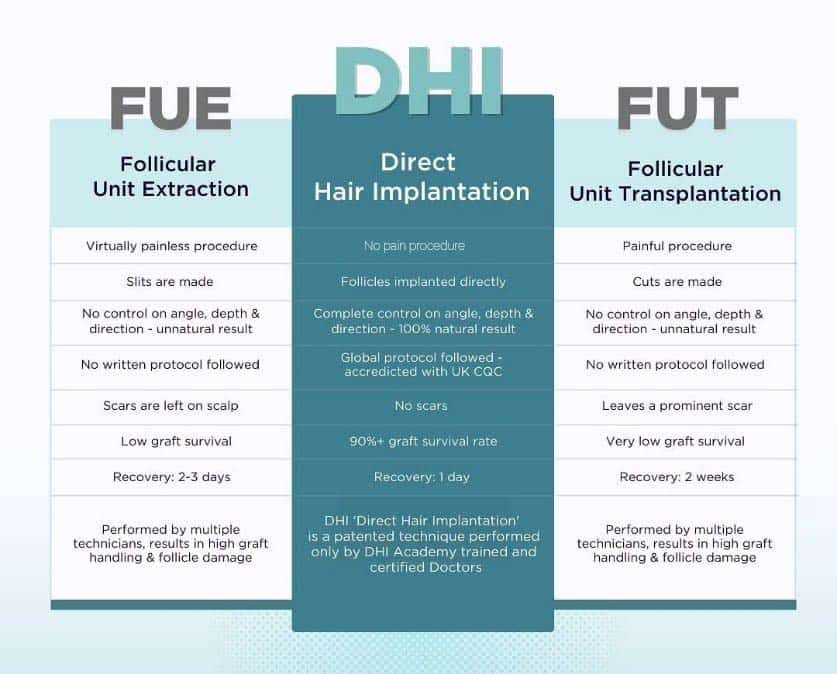DHI Hair Transplant vs. Robotic Hair Transplant Technique
Hair loss is a widespread concern, affecting nearly one in three people worldwide. It can result from various factors such as hormonal imbalances, dandruff, scalp infections, stress, and genetic predisposition. While these factors often play a role, hereditary pattern baldness stands out as the leading cause, accounting for the majority of cases—impacting millions of women and responsible for about 95% of hair loss in men.
Why Hair Transplant Procedure?
Hair transplantation remains the sole cosmetic surgical option for addressing a receding hairline or covering the bald area on the scalp and beard. During the procedure, healthy hair follicles are carefully harvested from the donor area at the back of the scalp and transplanted to the hairline or bald area to restore density and replicate the natural direction and angle of hair growth. The DHITM hair transplant technique is minimally invasive and typically carried out under local anesthesia.
7 Key questions you should ask before choosing your hair loss solution
1) Who will perform the procedure?
In most clinics, procedures are performed by technicians only. The clinic owners are plastic surgeons and dermatologists, mainly involved in sales and marketing. Their involvement in the actual procedure is minimal. It would help if you went to a clinic where a doctor performs the entire procedure himself/herself, not through a technician.
It is also important to check if the clinic/doctor specializes in hair transplants or offers other aesthetic treatments, such as Botox. A better choice would be to go for a super specialist doctor.
2) Is your doctor suitably trained and certified? Do they follow standard and accredited protocols?
Doctors often learn about hair transplants from other doctors without any evaluation or certification process. It can take years for them to understand the intricacies of hair transplants. Further, most doctors do not follow written protocols and perform procedures based on personal preferences, leading to sub-optimal results.
Please check if the doctor performing the procedure has training and accreditation from a reputed institute. Very importantly, personally verify if the clinic has written protocols for all stages of the hair transplant procedure, including detailed safety protocols.
3) What is the experience of the clinic/doctor you are going to?
Hair transplants are a relatively new area of practice, which has lured many doctors to leave their practice in the field of their expertise and move towards hair transplants only in the last 3-5 years. Many clinics may not have the experience, protocols, or necessary expertise to handle hair transplant cases. Please ensure that the clinic has been established for many years and has a verifiable reputation. Do not just rely on what they claim.
4) How does the clinic ensure the quality of your results?
Research shows that, on average, only half of the implanted hair may grow in certain clinics without proper experience. This is because the clinic may not have access to the latest techniques, instruments, tools, protocols, etc. Please avoid freelancers working in many clinics on a case-by-case basis. They will likely spoil your case as they may care least for the patient. Sometimes, the doctor may be very qualified or experienced but past his prime to be able to give good results.
Do check if the doctor’s work is supervised by someone. Does the doctor follow any certification, assessment, and quality monitoring process? It is not advised to go to a clinic where there is only one doctor whose work goes unsupervised.
Good results can only come with the right technique, instruments, tools, protocols, training, assessment, and quality control.
5) How do you ensure your safety during and after the hair transplant procedure?
Generally, hair transplants are safe and cannot lead to severe risks. However, sometimes scalp infections or even more severe conditions could occur if the correct safety protocols are not followed. This risk is very high when the procedure is performed by technicians or inexperienced doctors.
You are advised to ask relevant questions and follow the written safety protocols at the clinic.
Please see the procedure room and ask yourself if you feel confident about the safety protocols.
6) Would you go for a hair transplant without a proper evaluation of your alopecia?
The answer is obviously No. There are 10 kinds of alopecia. The correct treatment cannot be recommended unless a proper diagnosis is carried out. Many clinics recommend hair transplants without making a proper diagnosis. They also may not conduct a mathematical count of the donor and recipient areas to correctly assess the hair transplant requirement and feasibility. Please invest time and effort during your diagnosis and evaluate the doctor on proper dermatological examination diagnosis, precise donor and recipient area hair count, and computerized alopecia test. This results in a comprehensive lifetime treatment plan and the best results for your hair loss problem.
7) Should price play a role in choosing a hair transplant clinic or doctor?
Yes, of course, price is indeed a very important criterion. But you should not choose a clinic or doctor purely on the cost. Many doctors can reduce their costs significantly by reusing the instruments, compromising on safety standards, using technicians to do the procedures, etc. Quality and Safety come at a price. This is your investment in your safety and great-looking results for life. So, choose wisely.
Significance of DHI Hair Transplant Procedure:
Minimally Invasive – Unlike the traditional FUE hair transplant, the DHI™ technique requires no incisions, significantly reducing bleeding and discomfort.
Natural Results – The use of the DHI Implanter Pen allows precise control over the depth, angle, and direction of each graft, creating a hairline that looks completely natural.
Higher Graft Survival – With direct implantation, grafts spend minimal time outside the body, increasing their chances of survival.
Faster Recovery – The less invasive approach of DHI™ leads to quicker healing times for patients.
No Shaving Required – In the DHI™ hair transplant procedure, it doesn’t require shaving the recipient area, making it an ideal choice for professionals or those who prefer to keep their existing hair intact.
Safe and Certified – All DHI™ procedures are performed by trained doctors following strict safety protocols, ensuring the highest standards of care and safety.
How DHI Transplant Stands Out from Other Hair Transplants

DHI Implanter: Guarantees complete control of the angle depth and direction of the hair follicles and grafts.
No Scar on the Scalp: Compared with FUE or FUT, DHITM does not create slits 1st and then inject hair follicles, so it leaves no cut and scar on your scalp.
Natural results: Hair begins to grow in a way that is natural, in density, and direction, with the hair transplant procedure done by DHITM technique.
Less Invasive and More Convenient Procedure: Patients feel no pain and have quicker recovery times.
Exclusive Clinical Process: In comparison to several techniques, where technicians are usually engaged, DHITM allows solely skilled surgeons to conduct the procedure.
Robotic Follicular Unit Extraction (R-FUE):
A robotic FUE hair transplant technique is a technique of hair transplantation with a unique way wherein the healthcare provider uses a robotic device to extract hair follicles from the scalp.
An enhanced hair transplantation procedure involves:
Automated Follicle Extraction – A robotic system helps in scanning the donor area and identifies the best follicular units for extraction.
Digital Mapping – It digitally maps the scalp to provide an even distribution of grafts.
AI-Assisted Implantation – Certain robotic systems help with making recipient sites and placing the grafts in perfect angles.
Advantages of Robotic FUE
Precision: Using robotic technology, we will ensure that the proper grafts are harvested and placed.
Less Human Error: Because the process is automated, fatigue-related human error is less likely.
Quicker Method: The robotics can help to extract faster, and hence reduce the time needed to operate completely.
Limitations of Robotic FUE
Cost: Due to technology and the costs of maintenance, robotic procedures are costly.
Realistically Not Every Clinic Has Access to Robotic FUE
Absence of Design Personalizing the Hairline: Robots might boast precision, but the artistry of hairline design cannot be matched by any robot compared to the DHITM hair transplant procedure.
Risk of Over-extraction: Automated approaches might end up extracting more grafts than what is needed resulting in donor area depletion.
DHI vs. Robotic Hair Transplant: A Detailed Comparison
Robotic Follicular Unit Extraction (R-FUE):
A robotic FUE hair transplant technique is a technique of hair transplantation with a unique way wherein the healthcare provider uses a robotic device to extract hair follicles from the scalp.
An enhanced hair transplantation procedure involves:
Automated Follicle Extraction – A robotic system helps in scanning the donor area and identifies the best follicular units for extraction.
Digital Mapping – It digitally maps the scalp to provide an even distribution of grafts.
AI-Assisted Implantation – Certain robotic systems help with making recipient sites and placing the grafts in perfect angles.
Advantages of Robotic FUE
Precision: Using robotic technology, we will ensure that the proper grafts are harvested and placed.
Less Human Error: Because the process is automated, fatigue-related human error is less likely.
Quicker Method: The robotics can help to extract faster, and hence reduce the time needed to operate completely.
Limitations of Robotic FUE
Cost: Due to technology and costs of maintenance, robotic procedures are costly.
Realistically Not Every Clinic Has Access to Robotic FUE
Absence of Design Personalizing the Hairline: Robots might boast precision, but the artistry of hairline design cannot be matched by any robot compared to DHITM hair transplant procedure.
Risk of Over-extraction: Automated approaches might end up extracting more grafts than what is needed resulting in donor area depletion.
DHI International Medical Group: World’s Largest Hair Transplant Industry
DHI International stands at the forefront of the global hair transplant and hair restoration industry. With over 75 clinics spread across 45 countries, they have successfully treated thousands of patients worldwide. Renowned for its strict medical protocols, advanced technology, and a team of expertly trained specialists, DHI™ sets itself apart from other clinics. While many facilities rely on medical assistants or untrained personnel for hair transplant procedures, DHI™ ensures that only certified, highly skilled doctors carry out treatments, guaranteeing both safety and exceptional results.
Why Choose DHI International?
- All the surgeons performing transplants are certified.
- Minimal trauma with DHITM Implanter: This leads to enhanced natural hair growth.
- Zero Down Time: Not as slow as other methods to recover from hair transplant surgery.
- Natural Hairline and Density: DHITM gives you a natural hairline and hair density.
- Reliability/Legacy: 55 Years of Experience in the Hair Restoration field.
Direct Hair Implantation – DHITM and Robotic FUE Hair Transplant procedures both have their pros and cons as well; as a result, one can choose between them based on their requirements.
Decision:
DHI is the best option if you are looking for the best rate of Royal survival and less scarring.
Robotic Hair Transplant is a suitable choice if you want an overall quicker process, a more automated process, and slightly less surgeon-dependent expertise.
If you want a natural, high-hair-density hairline, then DHITM is best for you.
There are robotic techniques that can be used if the area is large and there is sufficient donor hair.
CHOOSE HAIR TRANSPLANT CHOOSE DHITM – DIRECT HAIR IMPLANTATION HAIR TRANSPLANT TECHNIQUE.
Conclusion
Hair loss can be very upsetting but can be addressed effectively with modern hair restoration methods. DHITM is considered to be a revolutionary technique as compared to the Robotic FUE hair transplant technique.
DHITM is considered one of the most precise, low-invasive, and with the highest rates of graft survival techniques, making it preferred by men and women who want to achieve long-lasting, natural results. Robotic FUE, on the other hand, delivers accuracy based on AI, requiring less manual workforce and maximizing efficiency.
Consult a hair specialist to figure out which method suits the hair loss pattern, budget, and expectation from a hair transplant procedure if you are in two minds about going in for which procedure.
Thanks to DHI International Medical Group results, the patients can have a full head of hair with zero risks involved and deliver the best natural results every single time.
With 75 locations across 45 countries, DHITM Medical Group is the most extensive network of hair restoration clinics worldwide. DHITM introduced the Direct Hair Implantation method in 2005, following its pioneering FUE in 2003. DHITM is the gold standard in hair restoration thanks to its top-notch facilities, US and EU patents, and scientific advisory board. DHITM keeps releasing novel therapies for different phases of hair loss. You are more than simply a patient at DHITM; our medical staff consider your best interests when treating you. Thousands of treatments, including those of celebrities like movie stars, athletes, politicians, and business moguls, have been completed by DHITM International Medical Group.






